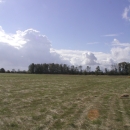What We Do
The National Wildlife Refuge System is a series of lands and waters owned and managed by the U.S. Fish and Wildlife Service. Sequoyah National Wildlife Refuge is unique because it is an overlay refuge. This means the land is owned by the U.S. Army Corps of Engineers and the U.S. Fish and Wildlife Service leases the land from them. Wildlife conservation is at the heart of the refuge system. It drives everything we do from the purpose a refuge is established, to the recreational activities offered there, to the resource management tools we use. Selecting the right tools helps us ensure the survival of local plants and animals and helps fulfill the purpose of the refuge.
Management and Conservation
Refuges use a wide range of land management tools based on the best science available. Some refuges use prescribed fires to mimic natural fires that would have cleared old vegetation from the land helping native plants regenerate and local wildlife to thrive. Other refuges contain Wilderness areas where land is largely managed in passively. The management tools used are aimed at ensuring a balanced conservation approach where both wildlife and people will benefit.
Sequoyah National Wildlife Refuge strives to mimic what once occurred naturally on the Arkansas River. It was historically a shallow, meandering, and ever-changing system that would seasonally create river pools, natural oxbow lakes, sloughs and shifting sandbars.
In 1943, the worst flood documented within this river system occurred and thus was born the idea to tame the Arkansas River and Verdigris tributary. The Robert S. Kerr Navigation System, managed by the Army Corps of Engineers, was established with the primary purpose of assuring navigation of the Arkansas River and power generation. The new project also included an effort to protect portions of the unique habitat.
Toward this effort, the Sequoyah National Wildlife Refuge was established as an overlay of the Army Corps of Engineers lands and consists of 20,800 acres of open water and riparian riparian
Definition of riparian habitat or riparian areas.
Learn more about riparian areas spread throughout the 42,000 acre project.
Because water levels are managed by the Army Corps of Engineers, the refuge’s management actions are focused primarily on the inland wetlands. These are controlled by water structures strategically placed for wetland creation and management. Most of these wetland impoundments are dependent on natural precipitation and are managed according to water availability.
The refuge’s main impoundments include Armstrong Dike, Sally Jones Lake and the Upper and Lower Scarbourgh. They are intensively managed for waterfowl, shorebird and wading bird food production. Many of the wetlands around the refuge are flooded by pumping during the fall, and the water levels are closely watched to provide adequate food for waterfowl. During the spring, the wetlands are drained and many of them are actively managed to provide a food source for waterfowl during the winter months.
Law Enforcement
Federal Wildlife Officers ensure the safety of the public and the protection of natural resources. They are essential to the wildlife conservation mission of the U.S. Fish and Wildlife Service and the agency’s efforts to manage ecosystems, save endangered species, conserve migratory birds, restore fisheries, combat invasive species invasive species
An invasive species is any plant or animal that has spread or been introduced into a new area where they are, or could, cause harm to the environment, economy, or human, animal, or plant health. Their unwelcome presence can destroy ecosystems and cost millions of dollars.
Learn more about invasive species and promote international wildlife conservation.
To report a violation on Sequoyah National Wildlife Refuge:
- Monday through Friday (7:30 a.m. to 4:00 p.m.), please call the Refuge Headquarters at 918-773-5251
- After hours or on weekends, please call 918-774-2832
Laws and Regulations
There are a lot of fun, interesting, and educational things you can do on the refuge. Keep in mind, if an activity is not wildlife related and doesn't help in the protection or understanding of wildlife or their habitat, there are probably refuge rules governing this activity. Please check with the refuge management before participating in an activity that could harm the environment or yourself. There are plenty of activities at Sequoyah National Wildlife Refuge for you to enjoy. Be safe and have fun!
